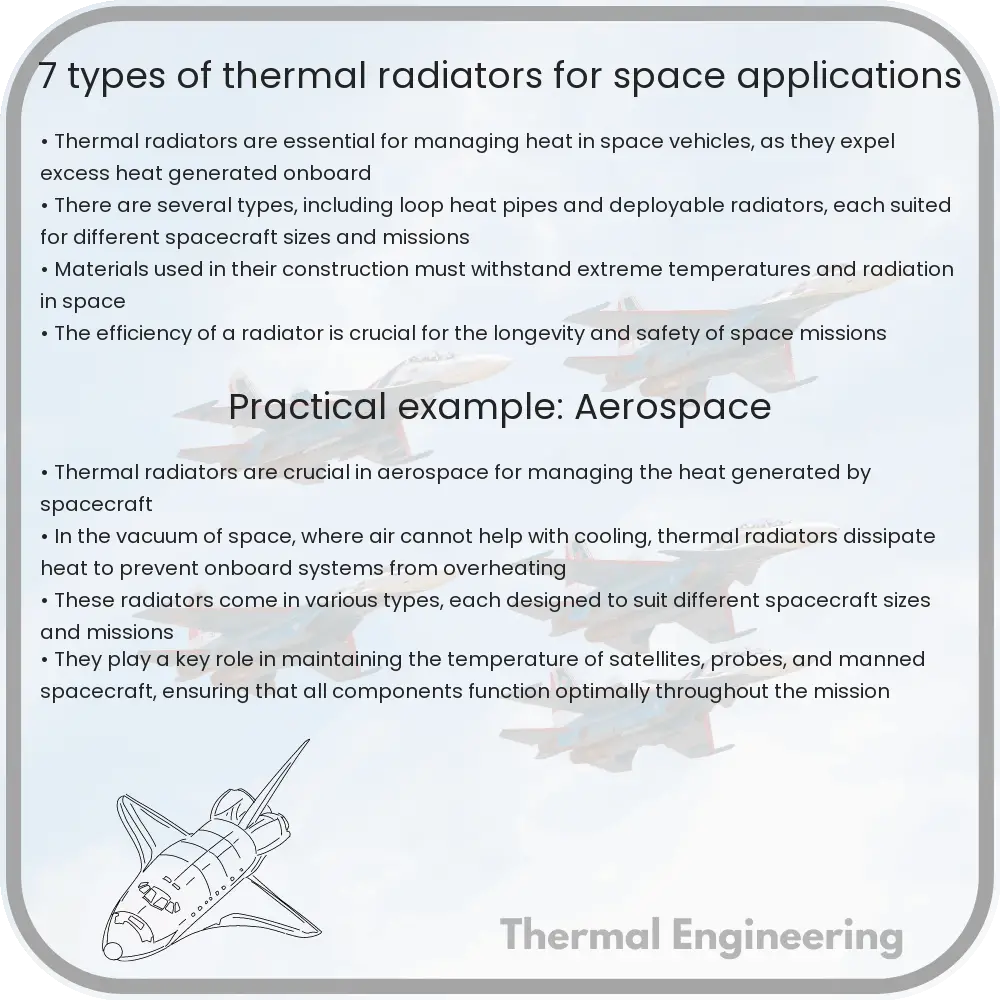Comprehensive overview of thermal radiators used in spacecraft for effective heat management in space environments.

Introduction to Thermal Radiators for Space Applications
Thermal management is a critical element of spacecraft design, ensuring that the temperatures remain within safe operational limits despite the harsh environment of space. Thermal radiators are specialized devices used for dissipating heat from spacecraft systems into space. There are several types of thermal radiators, each distinct in design and functionality suited for specific applications. This article explores seven types of thermal radiators used in space applications.
1. Panel Radiators
Panel radiators are among the most common types of radiators used in spacecraft. They consist of flat or slightly curved panels that emit heat through thermal radiation. These panels are typically made of materials with high emissivity, such as aluminum or silver-coated Teflon. The simplicity of their design makes them lightweight and easy to integrate into various sections of a spacecraft, including service modules and instrument bays.
2. Deployable Radiators
Deployable radiators are designed to unfold or extend once a spacecraft is in orbit. This capability is particularly useful for missions requiring a compact size during launch but needing increased radiative area in space. These radiators often utilize hinged panels or roll-out mats that increase surface area without a significant mass penalty.
3. Loop Heat Pipes (LHP)
Loop Heat Pipes are passive two-phase cooling devices that transport heat from a source to a thermal radiator. Using capillary action in a porous wick structure, LHPs manage heat effectively across long distances, allowing for flexible thermal control architecture on board spacecraft. The radiative portion of an LHP typically features fins or extended surfaces to maximize heat rejection.
4. Microchannel Radiators
Microchannel radiators use narrow, serpentine channels through which a heat transfer fluid circulates. The channels increase the surface area in contact with the fluid, enhancing the heat transfer efficiency. These radiators are often used in conjunction with other thermal management systems to handle high-density heat loads, especially in power electronic components.
5. Capillary Pumped Loops (CPL)
Similar to Loop Heat Pipes, Capillary Pumped Loops (CPL) utilize capillary action to transport heat but differ in their use of mechanical pumps to enhance circulation within the loop. This addition allows for more control over heat transfer rates and can be advantageous in larger systems where passive methods are insufficient.
6. V-Grooved Radiators
V-Grooved radiators use a series of angled grooves in the radiator surface to enhance radioactive properties. The V-shaped channels can be coated with different emissivity materials to optimize heat rejection capabilities. Their design helps in controlling the directional properties of thermal radiation, which is beneficial in maintaining the thermal balance of the spacecraft.
7. Heat Pipe Radiators
Heat pipe radiators incorporate heat pipes, which are highly efficient heat-transfer devices, within the radiator structure. These heat pipes efficiently transfer heat from the heat source to the radiator panel with minimal temperature drop. They can be arranged in arrays to form large, complex radiator systems capable of handling extremely high heat loads.
Conclusion
The choice of radiator type in space applications depends on various factors, including mission duration, environmental conditions, spacecraft design, and heat load characteristics. Engineers must carefully consider these factors to select the appropriate radiator type that ensures optimal performance and reliability of the spacecraft thermal management system. With advances in materials and thermal management technologies, the efficiency and functionality of space radiators continue to improve, pushing the boundaries of what is possible in spacecraft design.